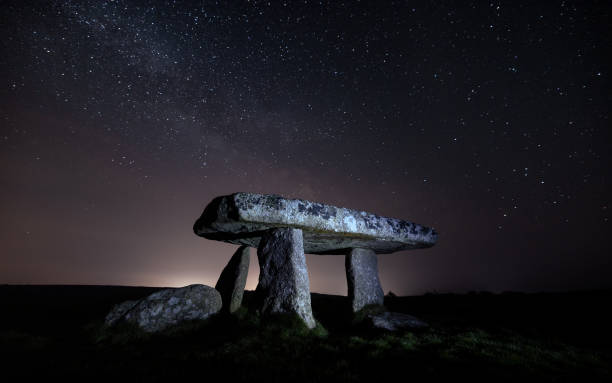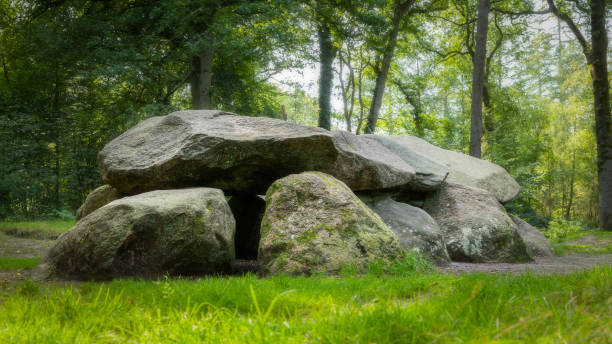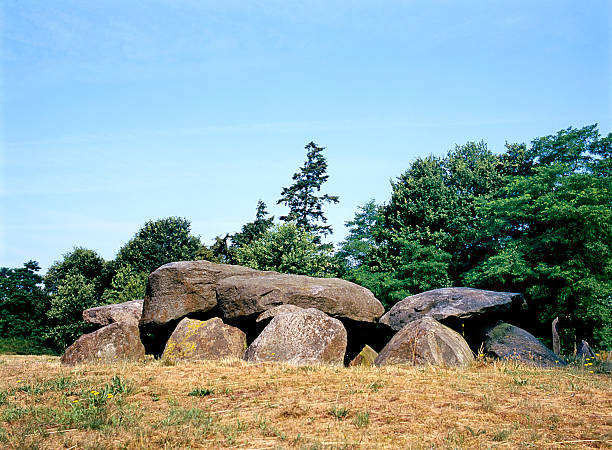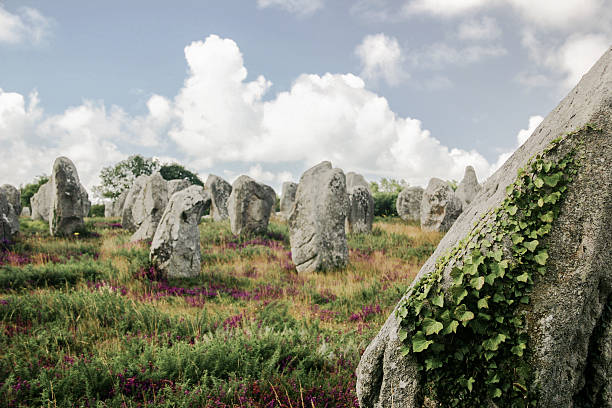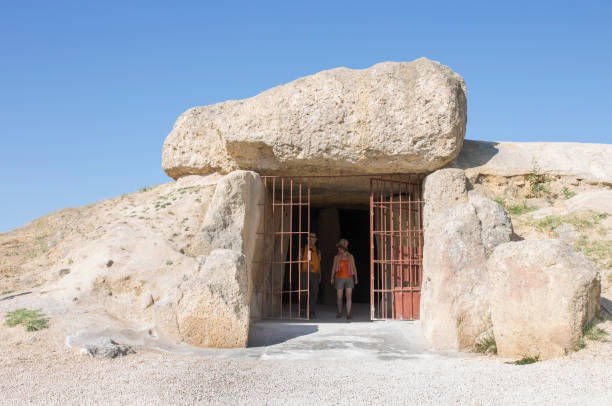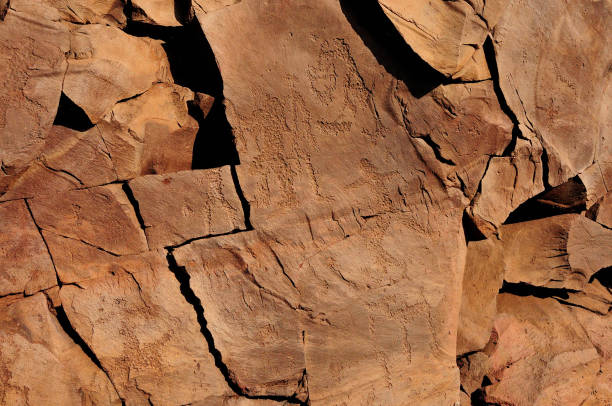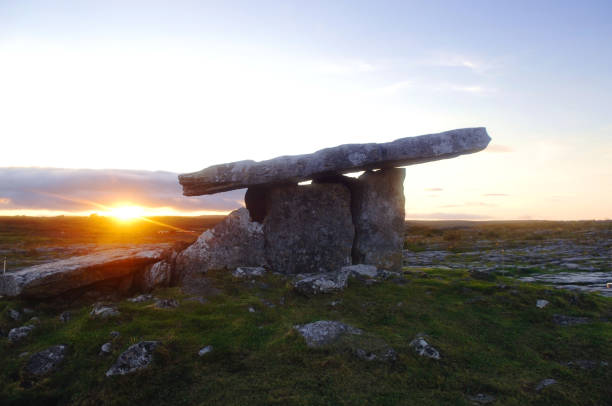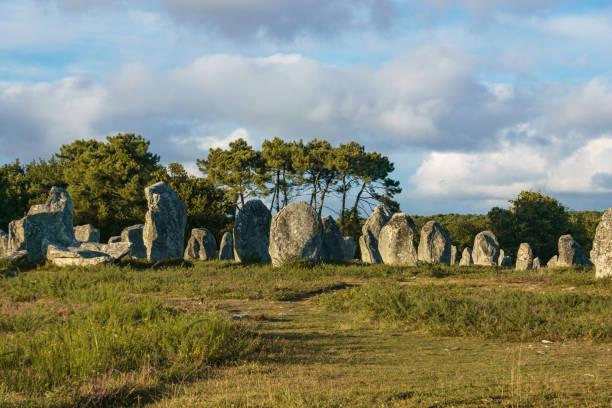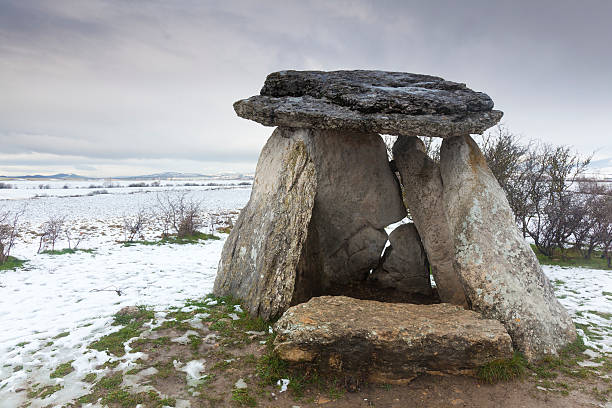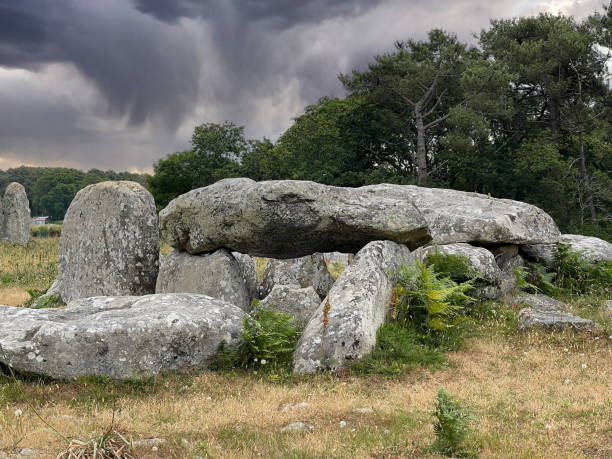
Dolmen Pictures, Images and Stock Photos
Browse 6,900+ dolmen stock photos and images available, or search for polnabrone dolmen or poulnabrone dolmen to find more great stock photos and pictures.

Dutch typical megalith stones in Drenthe sunrise just behind the stones with green grass and tree in landscape scene
D53 is the second largest hunebed in Holland (D27 is 'the first') and one with a remarkable history. It counts 9 capstones, all of them resting nicely on their foundations, consisting of 23 sidestones and 2 endstones. There is a complete porch with 4 passage sidestones and 1 capstone. Of the big oval wrench, 10 kerbstones are still there. Under the supervision of Professor Van Giffen D53 has been the subject of a thorough archaeologic research and not without success. In and under the floor of the burial chamber, researchers found potsherds of 665 pieces of pottery, 3 stone axes, an arrow-point, a bludgeon, and 4 amber beads. Never before so many artifacts had been found in a hunebed. In 1945 the fate of this marvelous hunebed seemed to be sealed. The German Army that occupied Holland demanded this megalithic monument to be dismantled for the construction of an airfield. The inevitable demolition took place, but the Dutch authorities had taken their precautions: all 50 big and smaller boulders were pushed into a 6 meter deep pit in the ground by a shovel. Immediately after the war the stones were dug up again and in 1949 the restoration started. In 1950 the hunebed showed off again in all its glory as if nothing had happened! Havelte, Netherlands
Dolmen of Sorginetxe at twilight
Dolmen the Romeral of stacked stones in Antequera, a World Heritage Site (UNESCO). Malaga, Spain
Dolmen in Coruña, Galicia, against a setting sun and horizon in silhouette.
Situated in largely unpopulated and treeless Cornish landscape between Madron and Morvah, Lanyon Quoit, along with other Cornish dolmens, dates back to the Neolithic period (3500-2500BC), predating both the pyramids in Egypt and metal tools. The original use is somewhat disputed; some believing that it was the burial chamber of a large mound and others contesting that it was never completely covered, but rather used as a mausoleum and the imposing backdrop to ritual ceremonies, especially since it is believed that in its original form the quoit was aligned with cardinal points. Another theory is that bodies were placed on the capstone to be eaten by carrion birds. Nearby lie a number of small stone burial chambers, knows as cists, with a longstone about 100 yards north-west of the quoit and evidence that there were once a number of neighbouring barrows. Once tall enough to allow a horse and rider to pass underneath, Lanyon Quoit is certainly one of Cornwall’s most recognisable and important megalithic sites. The mammoth capstone, weighing over 13 tonnes and measuring 9 feet by 17 feet, originally sat atop four upright stones until a thunderstorm in 1815 dislodged it. Attributed in part to soil removal from numerous treasure hunting explorations, the fall broke one of the supporting stones, hence the diminished stature achieved when re-erected by local public subscription (incidentally, the equipment used to replace the capstone was that previously used to replace the Logan Rock).
Poulnabrone, portal tomb in Ireland located in the Burren, County Clare, Ireland
Dolmen in the Dutch province of Drenthe with a background of oak trees. A dolmen or in Dutch a Hunebed is construction work from the new stone age.
Megalith dolmen D8 in the forest of Drenthe
The Dolmen de Menga is in the Spanish town of Antequera (Málaga). It is a covered gallery dolmen and almost rectangular plant, dating from the 3rd millennium BCE.
Hunnish megalithic Dolmen grave or hunebed near Assen, Drenthe, Netherlands
View of the interior chamber of the prehistoric site of the Dolmen of Menga, a burial mound megalithic structure, one of the largest known ancient megalithic structures in Europe, part of the UNESCO world heritage site know as Antequera Dolmens Site, Antequera, Malaga province, Andalucia region, Spain
Megalithic funerary monument
Black and white wide angle study of a dolmen in the Burren, Ireland.
Lycian rock tombs carved out on the cliff at Dalyan, Turkey
Lanyon Quoit, a megalithic dolmen site with a 12-ton capstone, Cornwall UK
Hunnic monolithic Dolmen tomb structure near Assen, Drenthe
The Dolmen de Menga is in the Spanish town of Antequera (Málaga). It is a covered gallery dolmen and almost rectangular plant, dating from the 3rd millennium BCE.
travel ireland. Brownshill Dolmen. vector illustration
Old stone grave like a big dolmen in Drenthe Holland. It is called in Dutch a Hunnebed
5 000 years old Polnabrone Dolmen in Burren, Co. Clare - Ireland
Ancient mysterious megalithic construction dolmen in Abkhazian forest, Azanta, Abkhazia
These dolmens exist in the Dutch landscape for over 5000 years. Older than the Egyptian pyramids! Built of huge granite stones, some of them weighing over 25,000 kilograms, dragged to the spot and piled up to form a rectangular stonegrave. There are still 54 of them. 52 in the province of Drenthe and 2 in the adjacent province of Groningen. "Hunebedden" as they are called in this country. Huynen means giants. These huge stones were brought here from Scandinavia during the ice age about 200,000 years ago.
Shooting of the Alignments of Carnac which are the most famous and impressive megalithic ensembles of this period with nearly 4,000 stones raised around 4500 YEARS BEFORE our era, at 18/135, 200 iso, f 16, 1/125 second
Prehistoric megalithic monuments menhirs in Carnac area in Brittany, France.
Dolmen at sunrise with clouds and green grass
Dolmen de Pedra Gentil in Catalonia in Spain
Antequera ,Spain - July 10, 2018: Visitors at entrance to Dolmen of Menga in Antequera. Dating from the 3rd millennium BCE
Colorful sunset over Pentre Ifan Burial chamber, Wales, England
"Kaunian rock tombs from Dalyan, Ortaca, Turkey"
view of prehistoric monolith stone alignments in Brittany in warm morning light with the sun shining brightly
The dolmens in the Netherlands forms the westernmost spur of the territory of the megalithic culture. There are about 54 dolmens in the Netherlands mostly in the Drenthe Province
Carnac, France - Famous rows of Prehistoric megalithic monuments menhirs in Carnac area in Brittany.
Tombs of ancient Lycian kings in the rock. Famous Lycian Tombs Of Ancient Caunos City, Dalyan, Turkey
A Korean burial mound (Dolmen) from the ancient Silla kingdom, reflected in the calm waters of a pond in the foreground.
Ancient rock paintings on a flat vertical surface of a red mountain. Mountain range Chests, Khakassia, Siberia, Russia.
Lightning over Sorginaren Txabola dolmen, Laguardia, Spain in Laguardia, Basque Country, Spain
Above the river's sheer cliffs are the weathered façades of Lycian tombs cut from rock, circa 400 BC.
Ancient portal dolmen, megalithic tomb, The Burren, Country Clare, Republic of Ireland.
Dolmen made of large Glacial erratic rock.
Ladas, Sassari, Sardinia, Italy - August 17, 2016: View of the dolmen of Ladas, a funerary archaeological monument located in Luras, in the area called Gallura.
Astrophotography shot with start trails around Polaris at Poulnabrone Dolmen in country Clare.
travel ireland. Brownshill Dolmen. vector illustration
The Tholos de El Romeral is in the Spanish town of Antequera (Malaga).
Dolmen de Tella in Pyrenees of Huesca Aragón of Spain in Sobrarbe area
The La Menga Dolmen, prehistoric burial chambers, megalithic tombs, Antequera, Andalusia, Spain
Dolmen Spain astro photo astronomy in Cáceres, Extremadura, Spain
A vector illustration icon of an ancient standing stone.
Dolmen of Sorginetxe, Agurain, Alava, Spain
Argenton Dolmen a few meters from the Saint-Gonveld Chapel in Landunvez.
Dolmen vector icon isolated on transparent background, Dolmen transparency logo concept
A Casiña da Moura, megalithic dolmen of Maus de Salas, Muiños, burial monuments in Ourense Province, Galicia, Spain






